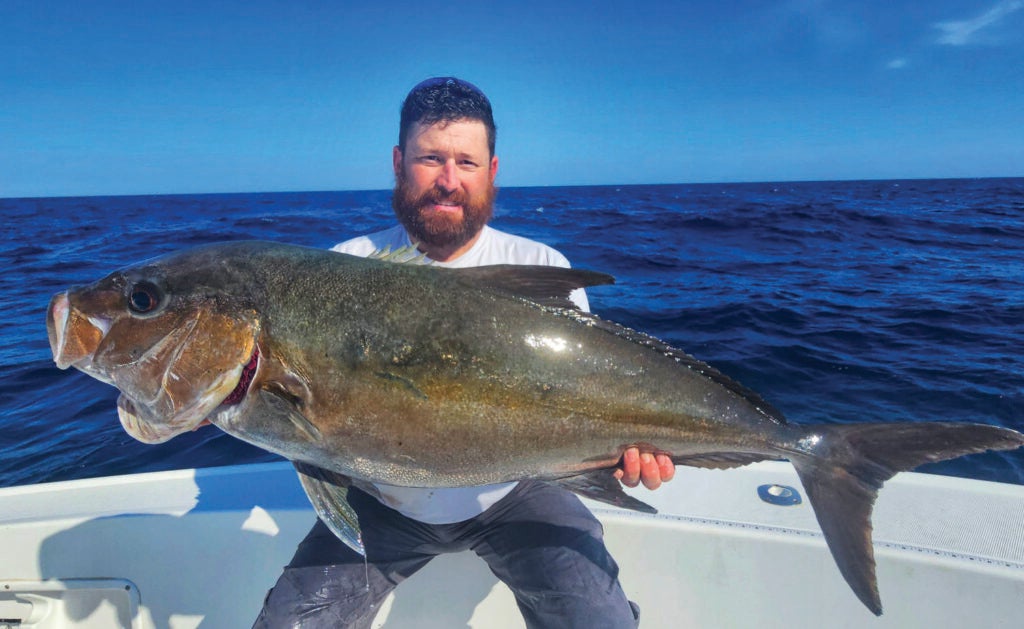DAN KIBLER COLUMN: Franklin County latest site where CWD discovered in deer herd
Published 3:51 pm Friday, December 1, 2023

- Matt Frattasio, a Massachusetts fisherman, set a North Carolina record with this 26-pound, 15.6-pounce Almaco Jack, caught Nov. 8 at a wreck out of Morehead City. (Contributed)
The march across North Carolina of chronic wasting disease continues.
The N.C. Wildlife Resources Commission last week announced that an even dozen white-tailed deer have been confirmed with the always-fatal neurological disease that affects deer and other members of the cervid family.
The latest infected deer is a 2½-year-old doe killed in Franklin County earlier this fall during gun season in the county north of Raleigh.
Biologist Brad Howard, chief of the Commission’s Wildlife Management Division, said this most-recent discovery — far removed from the original area where the disease was discovered, was disappointing, but he said it shows that the state’s program for detecting the disease is working.
“I want to point out that this detection in Franklin County, along with the last two unexpected CWD positive cases we detected in Johnston and Cumberland counties, doesn’t necessarily mean that CWD is spreading rapidly across the state,” Howard said.
“More likely, it means that all the sample submissions we are getting from hunters is really helping to find the places where CWD has already gotten a foothold in the state.
“It likely that it’s been in these places for a few years and had not been detected. I’d rather CWD not be here at all, but if it is here, I’m glad we are finding out about it as soon as possible.”
CWD can be transmitted between deer through saliva, urine and feces and the movement of infected deer carcasses. Deer appear healthy in early stages of the disease, often not showing any signs of neurological problems for a year or two.
Howard said that Franklin County will become a Primary Surveillance Area next year, and surrounding areas will become Secondary Surveillance Areas, with changes in deer regulations, sampling requirements and prohibitions on the movement of deer carcasses.
The original discovery of CWD in North Carolina was two years ago in Yadkin County. A second infected deer in Yadkin County was found the next year, then five in Surry County, one in Stokes County, one in Wilkes County, then one each in Cumberland, Johnston and Franklin County.
Big jack earns state-record distinction
The N.C. Division of Marine Fisheries said a Massachusetts angler has caught the first-ever state-record Almaco Jack, a 26-pound, 15.6-ounce fish caught near the D Wreck off Morehead City on Nov. 8.
Angler Matt Frattasio was fishing with Riptide Charters in 80 feet of water, using a live menhaden for bait, when he caught the big jack on a Hogy Tuna jigging rod mated with a Daiwa Saltist MQ 14000 reel spooled with 50-pound braid.
The big jack was 36.4 inches long (fork length) and 26 inches in girth. Officials at the Division’s headquarters in Morehead City weighed and identified the fish. There was no previous state-record for Almaco Jack, but the Division decided that Frattasio’s fish was so big — Florida’s state record is 35 pounds, 9 ounces — that it deserved to be considered a state record.
State will add 16 additional game wardens in 2024
The N.C. General Assembly has approved funding for 16 new wildlife enforcement officer positions, the first increase in the size of the N.C. Wildlife Resources Commission’s enforcement staff in 46 years.
Applications for the next Wildlife Law Enforcement Basic Academy training for current positions will be available next May.
The Commission’s enforcement staff will increase from 208 to 2224. Since the last increase in 1977, the sale of hunting, fishing and trapping licenses has increased by more than 200%, and North Carolina’s population has increased 87%.
Cam Ingram, the Commission’s executive director and a former wildlife enforcement officer, said, “Adding 16 new officer positions … will allow us to better protect and conserve our state’s wildlife, habitats and natural resources.”
State wants 50-fish limit on finger mullet
The N.C. Marine Fisheries Commission, which last month instituted a ban on all recreational harvest of striped mullet, aka finger mullet, until Jan. 1, 2024, has made recommendations for managing the coastal fish — popular for its roe and its value as a baitfish — that includes a 50-fish daily creel limit for recreational fisherman, along with restrictions for commercial fishing.
The recommendations will go to public comment at a series of public meetings from Dec 18 to Jan. 17.
The N.C. Division of Marine Fisheries determined in 2022 that the state’s striped mullet are overfished, and overfishing is occurring.
Recommendations affecting recreational fishermen include the 50-fish limit, plus a for-hire vessel (charter boats) limit equal to fish fish per angler the vessel is licensed to carry.

